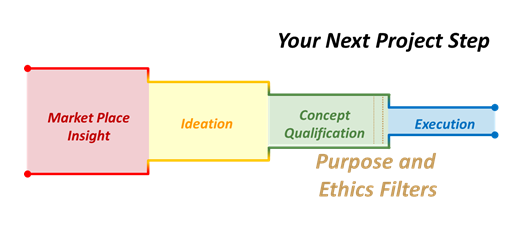Where does innovation start – with an idea or a need?
The answer to this question is – you will never know. Innovation is an idea-need match making that happens at the subconscious level. At the conscious level, the innovator believes idea came first, while the entrepreneur goes after the need first. While both may have been in the subconscious for a while waiting for a trigger to connect the dots.
Fundamental Innovation Process
Innovation Value Chain can be described as a series of connected steps, which lead to an innovative product, service, process, or a business model. Successful outcomes typically require an innovator to make assumptions at each step, validate or challenge them at the next step, go back if required, continuously build upon new learnings, and iteratively closeout on the purpose.

Deep Market Place Insight
The first major step in a structured innovation process is to define the need – a problem worth solving (customer insight) and the complimentary step is to see what already exists or is in works to solve the problem you have identified (competitor insight). At times you may need to address the regulatory hurdles as well.
Structured Ideation
This is the most creative and elusive step of the innovation, and generally, the source of the myth that you cannot teach innovation, or innovators are born. Ideation may not be science, but it is certainly not magic. It is probably an art, and sustained practice gets you to a state of mind that is continuously generating great ideas. Experience has shown that the ideas are not a random occurrence, but rather triggered by some form of an intellectual stimulus. This implies that we can create a stimulating environment or an exercise to generate hundreds of ideas. Quite often, an ideation session can lead to new markets, in addition to serving a specific pre-defined objective.
Market needs and Ideas can be iteratively refined once you realize and start to pursue the opportunity. In some sense, an innovator comes up with an idea, may see or create the need, that consumers may not yet see. An entrepreneur looks for market need/opportunity and figures out how to creatively meet it. I believe that it is a cognitive and elusive step, that artists can understand.
Purposeful Qualification
After a couple of iterations between marketplace problem and solution ideas, you will get to the stage of assessment of their worth. At this point, you must ask these three questions before investing any resources.
(1) Value Proposition: Does it add value to a customer/user/consumer?
(2) Purpose & Ethics Check: Does it fit your self-defined purpose and self-imposed ethical standards, in addition to being legally compliant? And
(3) Concept Qualification: Can you deliver it profitably, to sustain or grow your own business?
These steps will be iterative, more often than desired. It takes a bit of practice to get good at it.
Creative Execution
This is where you convert a qualified concept into reality. Most organizations and teams have a project management and gated process to mitigate execution risk. The ability to learn and adapt is still the key to successful innovation. Balanced portfolio approach can provide both stability and growth.
Alternatively – ISO 56002
ISO 56002:2019 Innovation Management System Guidance defines these 5 steps-
- Identify Opportunities
- Create Concepts
- Validate Concepts
- Develop Solutions
- Deploy Solutions
If you are interested in learning more about this process, please register for a free conversation with the author of the book on “Inspiring Next Innovation Value Chain”.
Buy Inspiring Next series Volume 2 – Innovation Value chain on Amazon.
If you have an opinion on the content presented above, please engage in a conversation and lets us refine it together.
